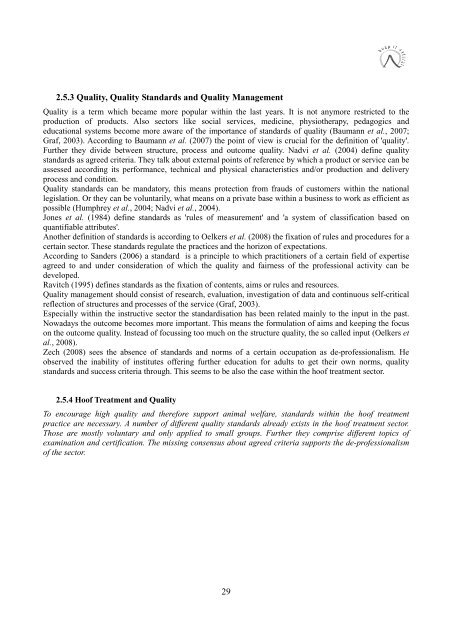Bachelor Thesis - Christina Kuenen - Hufpfleger
Bachelor Thesis - Christina Kuenen - Hufpfleger
Bachelor Thesis - Christina Kuenen - Hufpfleger
You also want an ePaper? Increase the reach of your titles
YUMPU automatically turns print PDFs into web optimized ePapers that Google loves.
2.5.3 Quality, Quality Standards and Quality Management<br />
Quality is a term which became more popular within the last years. It is not anymore restricted to the<br />
production of products. Also sectors like social services, medicine, physiotherapy, pedagogics and<br />
educational systems become more aware of the importance of standards of quality (Baumann et al., 2007;<br />
Graf, 2003). According to Baumann et al. (2007) the point of view is crucial for the definition of 'quality'.<br />
Further they divide between structure, process and outcome quality. Nadvi et al. (2004) define quality<br />
standards as agreed criteria. They talk about external points of reference by which a product or service can be<br />
assessed according its performance, technical and physical characteristics and/or production and delivery<br />
process and condition.<br />
Quality standards can be mandatory, this means protection from frauds of customers within the national<br />
legislation. Or they can be voluntarily, what means on a private base within a business to work as efficient as<br />
possible (Humphrey et al., 2004; Nadvi et al., 2004).<br />
Jones et al. (1984) define standards as 'rules of measurement' and 'a system of classification based on<br />
quantifiable attributes'.<br />
Another definition of standards is according to Oelkers et al. (2008) the fixation of rules and procedures for a<br />
certain sector. These standards regulate the practices and the horizon of expectations.<br />
According to Sanders (2006) a standard is a principle to which practitioners of a certain field of expertise<br />
agreed to and under consideration of which the quality and fairness of the professional activity can be<br />
developed.<br />
Ravitch (1995) defines standards as the fixation of contents, aims or rules and resources.<br />
Quality management should consist of research, evaluation, investigation of data and continuous self-critical<br />
reflection of structures and processes of the service (Graf, 2003).<br />
Especially within the instructive sector the standardisation has been related mainly to the input in the past.<br />
Nowadays the outcome becomes more important. This means the formulation of aims and keeping the focus<br />
on the outcome quality. Instead of focussing too much on the structure quality, the so called input (Oelkers et<br />
al., 2008).<br />
Zech (2008) sees the absence of standards and norms of a certain occupation as de-professionalism. He<br />
observed the inability of institutes offering further education for adults to get their own norms, quality<br />
standards and success criteria through. This seems to be also the case within the hoof treatment sector.<br />
2.5.4 Hoof Treatment and Quality<br />
To encourage high quality and therefore support animal welfare, standards within the hoof treatment<br />
practice are necessary. A number of different quality standards already exists in the hoof treatment sector.<br />
Those are mostly voluntary and only applied to small groups. Further they comprise different topics of<br />
examination and certification. The missing consensus about agreed criteria supports the de-professionalism<br />
of the sector.<br />
29


